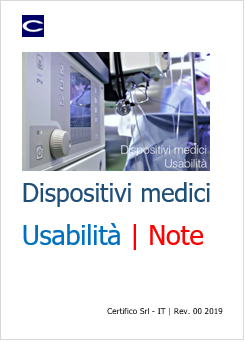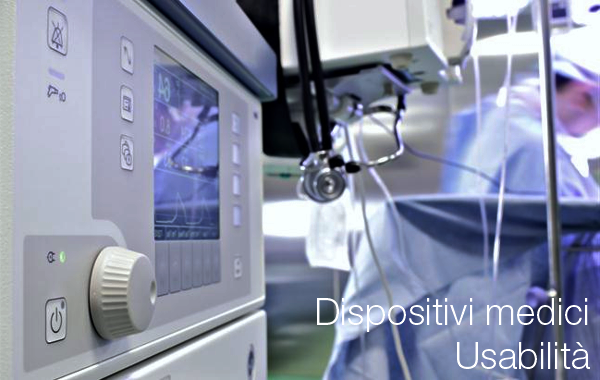Dispositivi medici: usabilità | Note 2019
| Appunti Marcatura CE | ||
| 26 Giugno 2025 | ||
| Salve Visitatore | ||
Dispositivi medici: usabilità | Note 2019 ID 7639 | 27.01.2019 Usability: Con questo termine – spesso tradotto in italiano con la locuzione “facilità d’uso” – si intende quella dimensione del prodotto/servizio connessa all’interazione che si stabilisce tra utilizzatore, prodotto e contesto d’uso, la cui criticità dipende dallo sforzo richiesto all’utente nell’ambito del processo d’uso. Un prodotto usabile ha le seguenti caratteristiche: - è facile da imparare ed è altrettanto facile ricordare come si utilizza; Ad oggi la tematica dell’usabilità sta assumendo sempre più rilevanza in ambito europeo e, conseguentemente, anche in Italia, da cui ne deriva la necessità che le apparecchiature siano sottoposte a test di “ingegneria dell’usabilità” che ne verifichino la facilità e la sicurezza di utilizzo. Anche per quanto riguarda i dispositivi medici (DM) è raccomandata l’esecuzione di preventive specifiche prove volte ad evitare eventi avversi connessi ad un impiego non “user-friendly”, per cui vengono prese in esame le attuali disposizioni legislative e raccomandazioni inerenti i DM ed i possibili connessi scenari di responsabilità in caso di danno. In particolare gli Autori analizzano gli scenari di contenzioso derivanti da un uso non sicuro dei DM: dall’ipotesi di “premigenia” responsabilità del Ministero della Salute per omessa vigilanza alla responsabilità del professionista sanitario e del medico da mancata segnalazione di un difetto a carico delle apparecchiature mediche utilizzate, sino a quella organizzativa della struttura sanitaria cui viene richiesto sempre più, nella quotidiana pratica operativa, di adeguarsi a protocolli e raccomandazioni internazionali.  CEI EN 60601-1-6:2005 - USABILITY Definition USABILITY: Characteristic that establishes EFFECTIVENESS, EFFICIENCY and OPERATOR learnability and satisfaction - EFFICIENCY resources expended in relation to the accuracy and completeness with which OPERATORS achieve goals - OPERATOR PROFILE summary of the mental, physical and demographic traits of the intended OPERATOR population, as well as any special characteristics that can have a bearing on design decisio ns, such as occupational skills and job requirements - ISO/IEC GUIDE 71, Guidelines for standards developers to address the needs of older persons and person with disabilities; (Allegata) _______ Allegati altri Documenti d'interesse sulla usabilità dei MD: - Linee guida usabilità DM FDA 2016 Raccomandazioni agli operatori Min Salute - Update 13 Dicembre 2018 Raccomandazioni Min. Salute | Ultimo aggiornamento 13 dicembre 2018 CEI EN 60601-1-6:2005 Variata da:
- CEI EN 60601-1-6/A1:2016 - CEI EN 60601-1-6/EC:2010
Apparecchi elettromedicali Parte 1: Prescrizioni generali relative alla sicurezza fondamentale e alle prestazioni essenziali - Norma collaterale: Usabilità INTRODUCTION Medical practice is increasingly using MEDICAL ELECTRICAL EQUIPMENT for observation and treatment of PATIENTS. USE ERRORS caused by inadequate MEDICAL ELECTRICAL EQUIPMENT USABILITY have become an increasing cause for concern. The USABILITY ENGINEERING PROCESS is intended to achieve reasonable USABILITY, which in turn is intended to minimisen USE ERRORS and to minimise use associated RISKS. Some, but not all, forms of incorrect use are amenable to control by the manufacturer. The USABILITY ENGINEERING PROCESS is part of the PROCESS of RISK CONTROL. This Collateral Standard describes a USABILITY ENGINEERING PROCESS, and provides guidance on how to implement and execute the PROCESS to provide MEDICAL ELECTRICAL EQUIPMENT SAFETY. It is intended to be useful not only for manufacturers of MEDICAL ELECTRICAL EQUIPMENT , but also for technical committees responsible for the preparation of particular standards. 1.202.3 Normative references The following referenced documents are indispensable for the application of this document. For dated references, only the edition cited applies. For undated references, the latest edition of the referenced document (including any amendments) applies. IEC 60601-1-8:2003, Medical electrical equipment – Part 1-8: General requirements for safety – Collateral standard: General requirements, tests and guidance for alarm systems in medical electrical equipment and medical electrical systems ISO 14971:2000, 2 Terminology and definitions
For the purpose of this collateral standard, the terms and definitions given in Clause 2 of IEC 60601-1:1988, as amended by the other collateral standards, Clause 3 of ISO 14971:2000 and the following apply.
NOTE An Index of all defined terms used in this collateral standard is found at the end of the document 2.201 ABNORMAL USE intended act or intended omission of an act by the USER or OPERATOR of EQUIPMENT as a result of conduct that is beyond any reasonable means of RISK CONTROL
by the manufacturer
NOTE 1 See also Annex BBB. Examples are given in Annex NOTE 2 It is possible for the PATIENT to be the OPERATOR, e.g. when EQUIPMENT is used in the PATIENT’S home NOTE 3 A BNORMAL USE is not considered REASONABLY FORESEABLE MISUSE 2.202 EFFECTIVENESS accuracy and completeness with which OPERATORS achieve specified goals
[ISO 9241-11:1998, definition 3.2, modified]
2.203 EFFICIENCY
resources expended in relation to the accuracy and completeness with which OPERATORS achieve goals
[ISO 9241-11:1998, definition 3.3 modified]
2.204 *OPERATOR-EQUIPMENT INTERFACE means by which the OPERATOR and the EQUIPMENT communicate [ANSI/AAMI/HE 74:2001, definition 3.24 modified] NOTE The ACCOMPANYING DOCUMENTS are considered part of the EQUIPMENT and the OPERATOR-EQUIPMENT INTERFACE. 2.205 OPERATOR PROFILE
summary of the mental, physical and demographic traits of the intended OPERATOR population, as well as any special characteristics that can have a bearing on design decisio ns, such as occupational skills and job requirements
2.206 *PRIMARY OPERATING FUNCTION
function that involves OPERATOR interaction that is either frequently used or related to the SAFETY of the EQUIPMENT in NORMAL USE
2.207 *REASONABLY FORESEEABLE MISUSE use by the OPERATOR in a way not intended by the manufacturer but which can result from readily predictable human behaviour
[ISO/IEC Guide 51:1999, definition 3.14, modified] NOTE 1 REASONABLY FORESEEABLE MISUSE is an intended action. 2.208 TRAINING application-specific OPERATOR-oriented instruction or exercises required for the safe and effective use of the EQUIPMENT 2.209 USE ERROR NOTE 1 USE ERROR includes slips, lapses, mistakes, and REASONABLY FORESEEABLE MISUSE. 2.210 USE SCENARIO Certifico Srl - IT | Rev. 00 2019 Collegati |
||
|
|
||
 |
||
| www.certifico.com
è un sito di INVIO NEWSLETTTER Se vuoi cancellarti dall'invio della newsletter oppure effettua il login al sito ed entra nella Tua Area Riservata, in “Modifica dati” agisci con la spunta sul box di selezione “nNewsletter”. L'Elenco completo di tutte le ns newsletter è qui: Archivio newsletter. |
||
  |
||
| Certifico Srl 2000-2019 | VAT IT02442650541 | ||


































